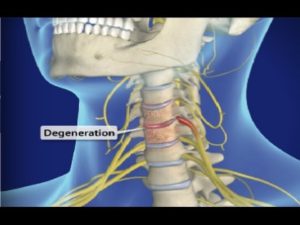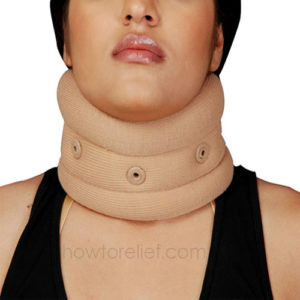Cervical Spondylosis: Cervical spondylosis is a medical term for neck pain caused by age-related ‘wear and tear’ of bones and tissues. The degenerative process of osteoarthritis chiefly affects the vertebral bodies, the neural foramina, and the facet joints.
If it may cause severe pressure on nerve roots with subsequent sensory or motor disturbances, which causes pain, paresthesia, and muscle weakness in the limbs.

Causes of Cervical spondylosis
Spondylosis is caused by years of constant eccentric pressure, from joint subluxation or poor posture, being placed on the vertebrae, and the discs between them. The aberrant stress causes the body to compose new bone in order to compensate for the new weight distribution. This eccentric weight bearing from bone displacement will cause spondylosis to occur.
Poor postures and loss of the mundane spinal curves can lead to spondylosis as well. Spondylosis can affect a person at any age; however, older people are more affected.
Cervical spondylosis is a very prevalent condition. It’s estimated that 8 out of 10 adults will have some degree of cervical spondylosis by the time they are 60 years old (but many will not have any conspicuous symptoms).
The most cases outlook of cervical spondylosis is generally good. Most cases respond well to treatment after a few weeks.
Symptoms of Cervical Spondylosis
Cervical spondylosis includes neck pain and shoulder pain. The pain can be rigorous in some cases.
Infrequent headaches may occur, that customarily start at the back of the head, just above the neck, and peregrinate over top of the forehead.
Pain conventionally comes and goes, with flare-ups followed by symptom-free periods.
Around 1 in 10 people develop perennial (chronic) pain.
Other, more severe, symptoms customarily only occur if you develop:
Cervical radiculopathy – where a slipped disc or other bone pinches or irritates a nerve
The most common symptom of cervical radiculopathy is the sharp pain that “travels” down one of your arms ( known as brachialgia).
You may experience some numbness or “pins and needles” in the affected arm, and stretching your neck and turning your head makes the pain worse.
Cervical myelopathy – where the spinal canal becomes narrower, compressing the spinal cord inside
Cervical myelopathy occurs when severe cervical spondylosis causes a narrowing spinal canal and compression of the spinal cord.
Diagnosis of Cervical Spondylosis
The Spurling test may be used to evaluate patients with cervical radiculopathy. The sign is elicited by extending, rotating, and laterally flexing the patient’s neck toward the symptomatic side. Then, the doctor applies axial pressure on the spine. Pressure applied on top of the head may increase symptoms.
The Spurling test has a sensitivity of 30% to 60% and a specificity of 90% to 100%, quite similar to those of other provocative maneuvers (low sensitivity but high specificity). This test helps confirms the diagnosis of cervical radiculopathy.
MRI and CT scans are helpful for diagnosis of pain but generally not definitive and must be considered together with history and physical examinations.
Cervical Spondylosis Treatment
Treatment for cervical spondylosis depends on the severity of signs of sickness. The goal of treatment relieves pain, help you maintain your normal activities as much as possible, and prevent permanent injury to the nerves and spinal cord.
Physical Therapy Management
There have been several trials and systematic reviews into the use of a physical therapy program for the treatment of cervical spondylosis and its consequences.
There are several types of manipulations and exercises your physiotherapist can utilize to relieve stiffness, strengthen the area, and restore the function of the neck. Treatments such as cold or heat application, deep tissue massage, neck stretching, ultrasound, and electrical stimulation may be used prior to exercise.
During physiotherapy, you practice a range of exercises to stretch and strengthen the muscles that support the neck. You also learn how to improve your posture and range of movement exercises. You have to learn correct postures, the physiotherapist stands in front of a mirror while exercising, so you can see your mistakes and correct them.

One technique sometimes to provide pain relief and improve movement by cervical traction. Traction gently extends the neck opening the spaces between the cervical vertebrae and temporarily relieve pressure on the affected discs. Neck traction either done continuously or intermittently (short periods of pulling and resting).
It’s also possible at home to do cervical traction. There are pulley system devices that enable you to perform cervical traction in lying down. It’s important if you do cervical traction at home to see your physiotherapist first to make sure that you buy the right things and learn how to correctly set up.

- Cervical pillows (neck pillows) are designed to stabilize the neck while you sleep.
- A cervical collar may also help you stabilize and realign your spine and relieve pain.
Medications
If over-the-counter pain medication doesn’t help, your doctor might prescribe:
- Non-steroidal anti-inflammatory drugs- Prescribe-strength ibuprofen or naproxen sodium might be needed to relieve pain and inflammation.
- Muscle relaxants- Certain drugs, such as cyclobenzaprine and methocarbamol can help relieve muscle spasms in the neck.
- Antidepressants- Antidepressant medications have also been found to help ease neck pain from cervical spondylosis.
Surgery
Cervical spondylosis tends to be a chronic pain condition, but in most cases, it’s not progressive. Only rare cases surgery is required.
Surgery may involve-
- Remove herniated disk or bone spurs
- Remove part of a vertebra
- Fusing a segment of the neck

